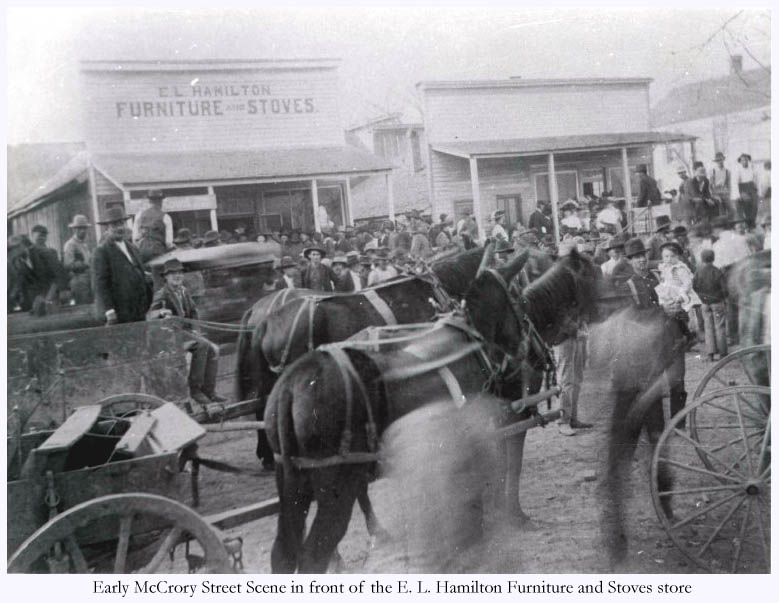

|
From "Sketch of McCrory in 1891" in the Arkansas Gazette, July 10, 1891, found in Rivers and Roads and Points in Between, Vol. XI, No. 1 (Augusta: Woodruff County Historical Society, Winter 1983), pp. 30-32: |
|
McCrory is one of the promising young towns of Arkansas. It is situated near the center of Woodruff County on the Bald Knob Branch of the Iron Mountain Railroad, seventy-two miles west of Memphis... McCrory is situated on the old McCrory homestead, from which the name is derived. The site of the town was settled in 1862, by C. G. McCrory, who lived on it till his death. C. W. McCrory, of Texas, a son of C. G. McCrory, bought the interest of the other heirs in then homestead, and has since owned it. Of course no thought of building a town here was ever entertained until the construction of the Bald Knob branch of the Iron Mountain Road made it possible. Mr. McCrory donated the right of way and a site for a depot to the railroad company, and about three years ago the town of McCrory started out upon its career. Mr. McCrory, in order to give the growth of the town his personal attention, about two years ago removed from Texas, where he is the possessor of fine bodies of land, and a sheep ranch, and has taken up his abode in the growing young town that bears his name. He has sold hundred of lots to settlers and comfortable homes are erected in every part of the town. There is an handsome Methodist Church, one of the finest in the State, outside of the city; twelve or fifteen stores, a hotel, a good school building, a wagon and blacksmith shop, livery stable, a newspaper and job office, a large stave factory, and numerous other enterprises and industries that go to make a town... Mr. McCrory, who still owns most of the town lots and the land immediately surrounding the town, as well as considerable real estate in the county, is bending every effort to expedite the growth of the town and is offering liberal inducements to investors who show evidence of becoming good and permanent citizens. What the farmers, merchants and real estate owners want is more people. They have plenty of room, a rich soil and in every respect a first-class community, and they want more people to enjoy these blessings with them. John Shearer, one of the oldest citizens of the county, does the largest mercantile business at McCrory and one of the most extensive in eastern Arkansas. He also has a store at DeView, two miles east of McCrory, where he has been in business for twenty odd years. The Oxley Stave Company, one of the largest manufacturing concerns in the county, have a mill here, which they are operating successfully... The mill here has on its payroll 260 men, which makes quite and item in the trade of the town. They ship about 200 car loads of stave per month and receive by rail about 150 car loads of bolts. The rest of their timber supply is furnished them by wagons...
|
|
|
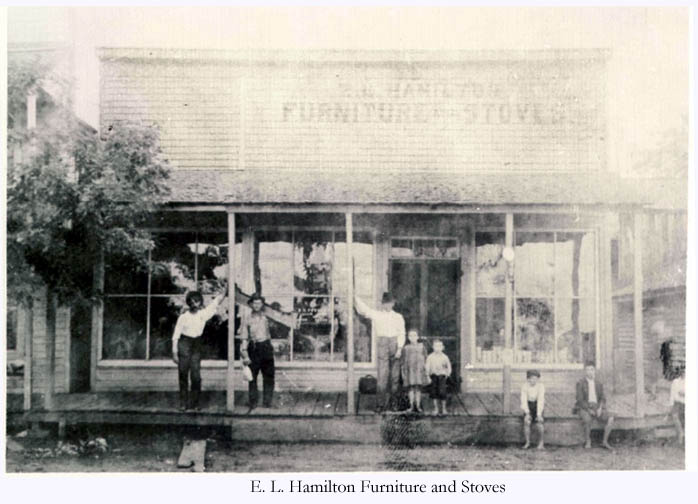
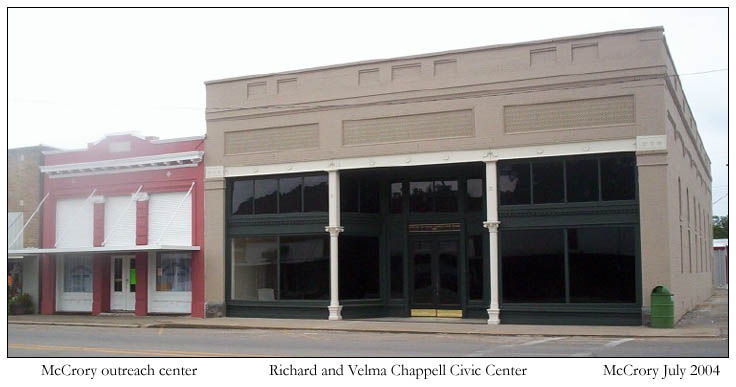
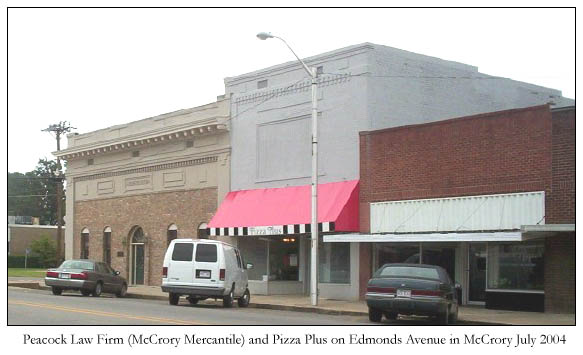
|
From "DeView-McCrory" by Dorothy Hamilton Bronte in Rivers and Roads and Points in Between, Vol. 1, No. 2 (Winter 1973), pp. 9-13: |
|
McCrory sprang up after the Missouri Pacific Railroad came through in 1886-87. Cyrus G. McCrory had bought for $3,500.00 in Confederate money the 400 acres of land where McCrory is now located and had moved his family here from Tuckerman during the early part of the Civil War. Cyrus McCrory and his wife, Mary Hamilton McCrory, originally were from Mason's Grove, Tenn. Their son, Wade McCrory, married Mollie Atkinson, and their children were Jordan C. McCrory, Miss Lou McCrory, Mrs. Della McCrory Jeffries, Mrs. Mary McCrory Jernigan, and Grover G. McCrory, none of whom is now living. Jordan C. McCrory was born in a double log house at the corner of Main and Fakes streets, Feb 5, 1870, and when he was four months old the McCrory family moved away, first going to Batesville for five years, then to Waco, Texas. By the time the family returned to McCrory in 1890, the railroad had come through, the town was started, and a group of 55 men had signed the incorporation petition on Dec. 24, 1889, a petition granted by the county court on Jan. 30, 1890. When the McCrorys were away, Dr. Gideon B. Fakes managed their affairs here. When the railroad came through, Dr. Fakes negotiated for the McCrorys. When the town was platted in September, 1886, Dr. Fakes was in charge. The first brick building in McCrory was what is now the Fraser building, where the Arkansas Power and Light Company had its offices. It was built for the Bank of McCrory, organized June 8, 1903, with H. W. Jernigan as its first cashier. (Mr. Jernigan later became bank president). In 1909, deciding that the building was too far out of town, bank officials had a new building erected... and moved the bank into it. Meanwhile, a Planters and Merchants Bank had been organized and had erected a building across the street from where the first bank was located, at the southwest corner of Edmonds Avenue and Second Street; and in 1917, after the Planters and Merchants Bank, "went broke", the Bank of McCrory purchased that building... in 1889 the post office was in the rear of the Watson-Wilder building, with Fred Watson as postmaster. When the administration changed, Ed Bonner became postmaster, and moved the post office to the rear of the store... When Dr. Neal became postmaster, he had the office moved to the building where the Bank of McCrory had first located. During the postmastership of Bruce Fakes, about 1908 to 1912, the post office was in the building where the M. D. Thompson & Sons office is now. After the postoffice was moved, George Proulx opened a restaurant in the building, and persons who have lived in McCrory that long still can remember Mr. Proulx driving to work each morning in his horse-drawn cart... By 1910, several large brick buildings along Edmonds Avenue had been built. The McCrory family had erected the Planters Mercantile building in 1908. E. E. Jeffries and Walter Fakes had a drug store for a time in what is now the Bull building. Later, Dr. Piercey's drug store was erected in 1909 adjoined on the north the Fakes Mercantile building at the northeast corner of Main and Edmonds. Across the street in the south, the Thompson-Hailey building had been erected by Maynard Thompson (who had operated a store at Grays when he first came to Woodruff County) and Clayton Hailey. Later, Mr. Thompson bought Mr. Hailey's interest, and the Hailey family moved to Little Rock. Mr. Thompson was the father of the late Vance M. Thompson, whose children still operated his extensive farming and other interests, although the store building was destroyed by fire about 1960... The first school in the McCrory area was about a mile north of McCrory, in a barnlike structure east of "the old pine tree" which was left standing when the residential area was developed there a few years ago; but the first school in the McCrory city limits (then) was held in the 1890's in the "Arnof Hotel" building on the southwest corner of second and Jackson streets... The old McCrory Baptist Church was erected about 1910, and was remodelled into an education building when the new church was built. The old Methodist Church burned, and was replaced with a large brick structure in 1916. This building burned in 1932. The present building was dedicated in 1934. Churches of other denominations have been erected since then... A sister of Wade McCrory married a man named Seamon, and the next street east of Jackson Street, and parallel to it, was named "Seamon." Somewhere, sometime, someone changed the spelling to "Seaman", probably because hand-written "a's" and "o's" frequently look alike, and the street signs on that street all read "Seaman" instead of "Seamon." After McCrory's street signs were installed, someone mentioned it to the late Grover McCrory, (Wade McCrory's son), and he laughed about it, but new signs have not been erected since then.
|
|
|
|
From "Woodruff County's Disastrous Fires," by T. J. Fakes, Rivers and Roads and Points in Between, Vol. XIV, No. 1 (Winter, 1986), pp. 14-17: |
|
... 14 Jan., 1909--The business houses of Thompson-Hailey, H. Arnof and E. T. Wherry were consumed by fire. The second floor of the Wherry Building was used by the Woodmen of the World, Odd Fellows, K & L of H and other lodges who lost all of their regalia. 27 Oct., 1909 --This disastrous fire destroyed the block of frame buildings from railroad to Main St. on Edmonds Ave. and around the corner on Main St. to the dental clinic of Dr. Startup. The buildings were occupied by Holland's Tailor Shop at the railroad; Edgar Marsh's meat market where the fire started; Joe Daily's; Hamilton's Furniture Store; Stoker's Barber Shop and W. B. Kyle's Music Store. On Main St. was the Hamilton Store annex; office of Dr. L. A. Jelks and Proulx's Cafe. The home of Harry Walker next door was saved by valiant efforts of the towns people and survives to the present at 112 West Main St.
|
|
|
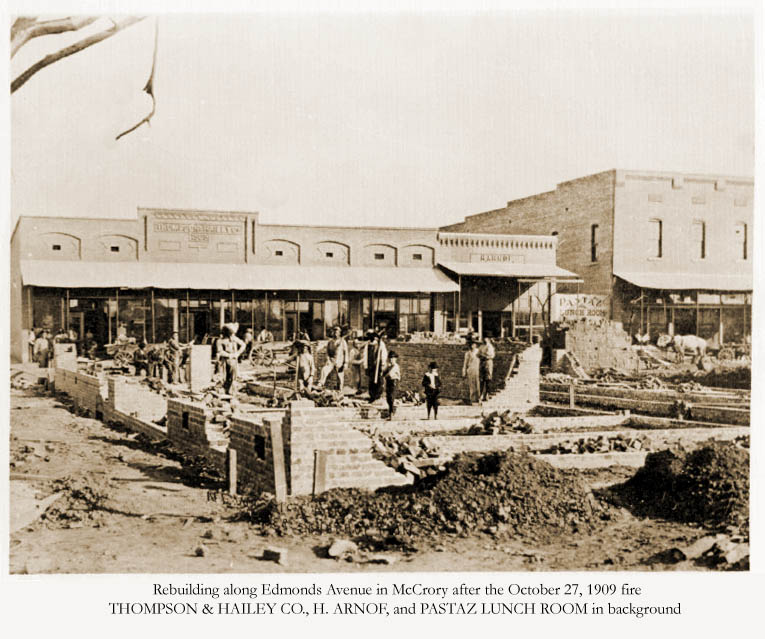
|
A history of the McCrory Postoffice (founded 30 December 1887), including a list of postmasters and carriers can be found in "Post Office at McCrory, Arkansas, Rivers and Roads and Points in Between, Vol. VIII, No. 2 (Spring, 1980), pp. 2-6.
Many thanks to Kip Davis for the photographs used on this page. |
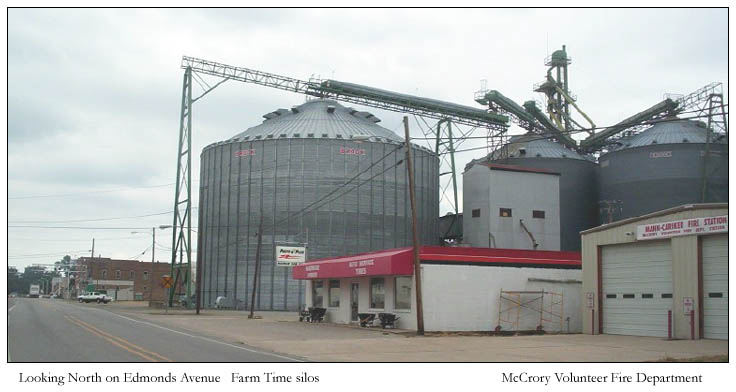
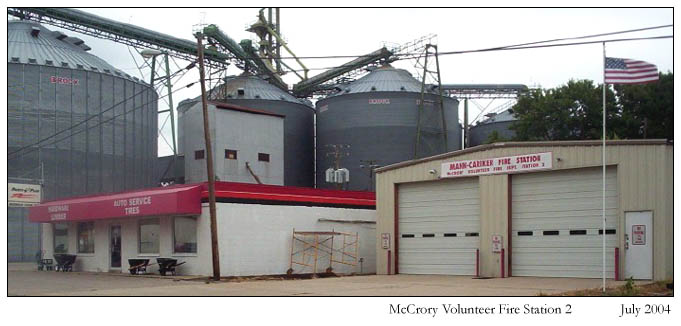
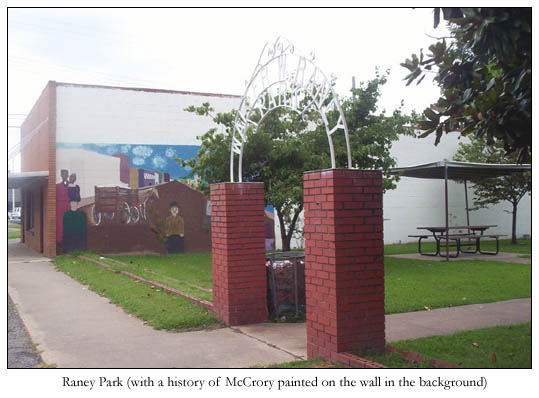
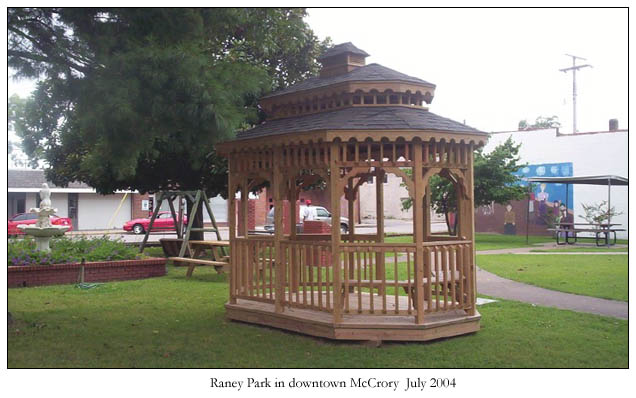
![]()
This page created on 09/06/2000 21:45. Updated 07/26/04 23:36.